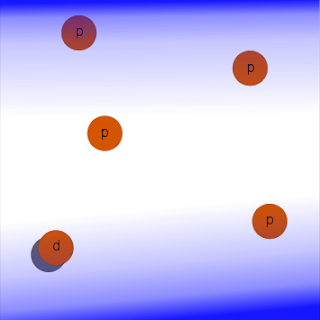Step 1: fusion precursors are far away from one another in the context of an environment at the surface of or a few layers into a host metal, and the likelihood of fusion is negligible. For the sake of illustration, we'll consider hydrogen and deuterium.
The blue gradient represents the electron charge density. The closer free atoms get to the lattice sites in the host metal, the stronger the charge density and the more the electrons on the atoms are stripped off and the atoms behave like ions.
Step 2: a transient in the charge density forms somehow; perhaps there has been a spark discharge:
As a result of the transient, the charge density becomes very high; simultaneously, any atomic hydrogen and deuterium nearby are ionized.
Step 3: the negative charge of the transient becomes so high the now-ionized p's and d's are attracted to and cluster around it.
The ions are so strongly drawn in by the transient that they are brought into close vicinity to one another as well. The stronger the transient, the closer they are drawn; the longer-lasting the transient, the longer they will remain nearby one another. A z-pinch might also be involved here, in which a confining magnetic field is formed by current.
Step 4: the likelihood of a p and a d tunneling is a function of their proximity to one another and the amount of time that they linger. Suppose the strength of the transient and its duration are sufficient to allow tunneling of one of the p+d pairs. The result is a very unstable [pd]* resonance that will quickly decay:
Step 5: instead what might happen is the momentum of the reaction ends up being divided among a large number of electrons in the area, immediately resulting in the emission in every direction of a corresponding number of lower-energy photons:
Step 6: after the transient has subsided, what is left over is heat from the bath of lower-energy photons together with a slow-moving 3He daughter:






No comments:
Post a Comment